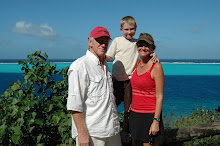
Considered by some to be the most beautiful anchorage in the Marquesas, the bay at Fatu Hiva offered us perfectly calm seas nestled between fjord-like mountainsides, peering into a valley at the head of the bay. The wind whips fervently down the valley to cool us and stabilze the boat direction - no stern anchor needed here. A constant cloud cover looms over the peaks, providing much needed moisture to the lush foliage and occassionally blessed us with a refreshing rain shower. Hoping to bask in the glory of a 300 foot waterfall, we hiked more than an hour through the tropical forest only to discover the low rain levels converted the falls into a 300 foot trickle. The swimming hole was yet inviting and refreshing.
With a population hovering around 300, little activity rustles this pristine setting. Rather than wait for our arrival, the locals with something to offer came by our boat soon after we anchored. We were invited to dine at Seirge's home where the women would cook a traditional meal while Seirge played the ukelele with his cronies and displayed his wood carvings. A couple other men brought tapas (ink drawings on flattened bark) and carved wood statues for our perusal and purchase. They also made it known any extra wine on board would be appreciated - valuable information when later we elicited their help in jump-starting our dinghy battery for which we happily exchanged a couple bottles of the red stuff. Maur ice likes his wine!
ice likes his wine!
 ice likes his wine!
ice likes his wine! Traditional dinner at Seirge's consisted of cooked goat in coconut milk atop rice, marinated raw fish with cucumbers and tomatoes, breadfruit (a local fruit with a starchy texture), and bananas prepared in unique ways that made them look like vienna sausages but squishier and very sweet.
Of the eighteen cruisers who turned out for dinner at Seirge's, we were the only Americans. This is truly international cruising grounds. We have seen boats from all over the world - South Africa, Scotland, Norway, New Zealand, Canada, Australia, to name a few.

